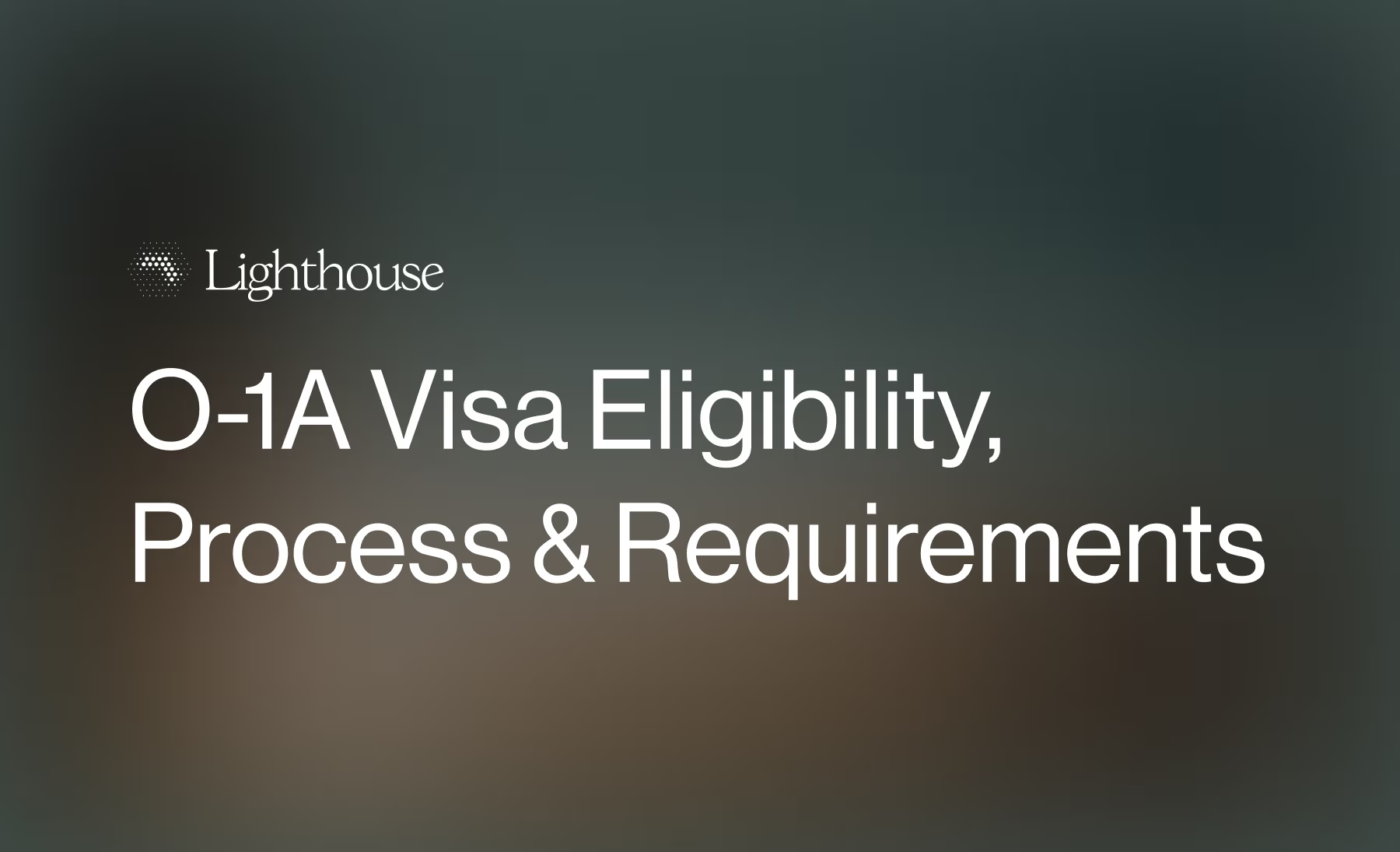The EB-1 Visa Explained
Your complete guide to the EB-1 green card for top-tier professionals.


For professionals, researchers, and executives who have reached the top of their field, the EB-1 visa offers a direct path to permanent residence in the United States. This guide explains the different EB-1 categories, eligibility criteria, and how the application process works for you and your family.
What is the EB-1 Visa?
The EB-1 is an employment-based immigrant visa that leads directly to a green card. It is reserved for individuals with a demonstrated record of extraordinary achievement in their field of expertise and is perhaps the most sought-after visa classification for permanent residence.
The EB-1 visa process does not require a PERM labor certification from the U.S. Department of Labor. This certification is also required for other employment-based green cards, like the EB-2. It is a lengthy process designed to test the U.S. labor market. Bypassing this step makes the EB-1 a much faster route to a green card.
U.S. Citizenship and Immigration Services (USCIS) divides the EB-1 into three distinct subcategories, each with its own specific criteria:
- EB-1A: For individuals with extraordinary ability.
- EB-1B: For outstanding professors and researchers.
- EB-1C: For multinational managers and executives.
Each subcategory has distinct eligibility criteria and documentation standards, but all lead directly to a green card.
Quick Comparison of EB-1 Visa Types
The Three EB-1 Categories
Qualifying for an EB-1 visa depends on your professional profile and meeting the high standards set by USCIS. Each category is designed for a different type of top-tier professional.
EB-1A: Extraordinary Ability
The EB-1A category is for individuals who can demonstrate extraordinary ability in the sciences, arts, education, business, or athletics through sustained national or international acclaim. This is a flexible EB-1 visa category because you can file your own petition; you do not need a job offer or sponsorship from a U.S. employer.
To establish eligibility, you must prove a high level of achievement. This can be done in one of two ways:
- Show evidence of a one-time major, internationally recognized award, such as a Nobel Prize, an Academy Award, or an Olympic medal.
- Provide evidence that meets at least three of the ten criteria listed in the USCIS policy manual:
- Membership: Membership in associations that require outstanding achievements, as judged by recognized national or international experts in their disciplines or fields.
- Published Materials: Published material in professional or major trade publications or major media about the beneficiary, relating to the beneficiary's work.
- Judging: Participation on a panel, or individually, as a judge of the work of others in the same or in an allied field of specialization.
- Original Contributions: Evidence of original scientific, scholarly, artistic, athletic, or business-related contributions of major significance to the field.
- Authorship: Authorship of scholarly articles in the field, in professional journals, or other major media.
- Exhibitions: Evidence that the beneficiary’s work has been displayed at artistic exhibitions or showcases.
- Critical Role at a Distinguished Organization: Employment in a leading or critical capacity for organizations and establishments that have a distinguished reputation.
- High Remuneration: Commanded or will command a high salary or other significantly high remuneration in relation to others in the field.
- Commercial Success: Proof of commercial successes in the performing arts, such as box office receipts, record sales, or streaming performance data.
You may notice that the criteria for the EB-1A green card are similar to the criteria required for the O-1A and O-1B work visas. While the criteria generally fall into the same categories, the EB-1A is significantly more selective than O-1A or O-1B, and the bar for each of these criteria is generally much higher.
EB-1B: Outstanding Professors and Researchers
The EB-1B category is for professors and researchers with advanced degrees who are recognized internationally for their outstanding achievements in a particular academic field. This category requires a job offer and sponsorship from a petitioner, which must be a U.S. university, institution of higher education, or a private research organization.
To qualify, you must:
- Have at least three years of experience in teaching or research in your academic area.
- Be seeking to enter the U.S. for a tenured or tenure-track teaching position or a comparable research position.
- Provide a job offer from a qualifying U.S. employer.
You must also submit supporting documents showing you meet at least two of the following six criteria:
- Receipt of major prizes or awards for outstanding achievement.
- Membership in associations that require their members to demonstrate outstanding achievement.
- Published material in professional publications written by others about your work in the academic field.
- Participation, either on a panel or individually, as a judge of the work of others in the same or an allied academic field.
- Original scientific or scholarly research contributions in the field.
- Authorship of scholarly books or articles in scholarly journals with international circulation in the field.
EB-1C: Multinational Managers and Executives
The EB-1C category is designed for managers or executives who are transferring from an overseas company to work for a related U.S. company. The petitioner must be a U.S. employer that has been doing business for at least one year and has a qualifying relationship with the foreign entity where you worked.
The eligibility requirements include:
- You must have been employed outside the U.S. for at least one of the three preceding years by a firm or corporation.
- Your employment must have been in a managerial or executive capacity.
- You must be seeking to enter the U.S. to continue service to that firm or organization in a managerial or executive capacity.
USCIS defines "managerial capacity" as having duties that include managing the organization, supervising other professional employees, and making high-level operational decisions. "Executive capacity" involves directing the management of the organization and establishing goals and policies with wide latitude in discretionary decision-making.
A Step-By-Step Guide to the EB-1 Visa Application Process
The journey to an EB-1 green card is a multi-stage process involving detailed documentation and review by several government agencies.
Step 1: Filing Form I-140
The first step is for the petitioner to file Form I-140, Immigrant Petition for Alien Worker, with USCIS.
- For EB-1A, you can be your own petitioner and file on your own behalf.
- For EB-1B and EB-1C, your U.S. employer is the petitioner.
The Form I-140 petition must be accompanied by extensive supporting documentation that proves you meet the specific criteria for your subcategory. This evidence can include award certificates, letters of recommendation from recognized experts, published material, patents, contracts showing a high salary, and other proof of your outstanding achievements.
Step 2: USCIS Review and Approval
Once the petition is filed, USCIS will review it to determine your eligibility. The standard processing time for Form I-140 can vary. You can request Premium Processing by filing Form I-907 and paying an additional fee, which guarantees USCIS will take action on your case within 15 calendar days. An "action" could be an approval, a denial, or a Request for Evidence (RFE) if more information is needed.
Step 3: Waiting for Visa Availability
After your I-140 is approved, you must wait for an employment-based immigration visa to become available. This is determined by your "priority date," which is the date your I-140 was filed. You can check visa availability in the Department of State's monthly Visa Bulletin. For the EB-1 category, visa numbers are often "current" for most countries, meaning there is no backlog or waiting period.
Step 4: Applying for the Green Card
With an approved I-140 and a current priority date, you can apply for your green card. There are two paths for this final stage:
- Adjustment of Status (Form I-485): If you are already in the United States in a valid nonimmigrant status (such as H-1B or O-1), you can file Form I-485 to adjust your status to permanent resident.
- Consular Processing: If you are outside the U.S., your case will be transferred to the Department of State's National Visa Center (NVC). The NVC will process your case and forward it to the appropriate U.S. embassy or consulate in your home country, where you will attend an interview.
Step 5: Medical Exam and Biometrics and Biometrics
All applicants for permanent residence must undergo a medical examination with a USCIS-approved civil surgeon. You will also be required to attend a biometrics appointment to provide fingerprints, a photograph, and a signature for background checks.
Step 6: The Interview and Final Decision
If you are adjusting your status, USCIS may waive the interview, but many applicants are still required to attend one. For consular processing, an interview is mandatory. The consular or USCIS officer will ask questions about your green card application and background. Upon approval, you will become a lawful permanent resident of the United States and receive your green card.
Your Family: Bringing Dependents With You
When you apply for an EB-1 visa, your spouse and unmarried children under the age of 21 are also eligible for permanent residence as your dependents. They can be included in your adjustment of status application or apply for immigrant visas at a U.S. embassy or consulate alongside you.
Once approved, your family members will receive their own green cards, granting them the right to live, work, and study anywhere in the United States without restriction.
What It Costs: A Breakdown of EB-1 Visa Fees
The government filing fees associated with the EB-1 visa application process can be substantial. The primary costs are:
- Form I-140 Filing Fee: $715. For EB-1B and EB-1C petitions, the employer must pay this fee.
- Form I-485 Filing Fee: $1,440 per applicant for adjustment of status (includes biometrics fee).
- Consular Processing Fees: Approximately $445 per person, which includes the DS-260 immigrant visa application fee and the Affidavit of Support fee.
- Premium Processing Fee (Optional): $2,805 for expedited processing of the Form I-140.
Other costs may include the medical exam, translations, employment authorization verification, and document courier services. These fees are subject to change, and you should always check the official USCIS fee schedule before filing.
How to Make a Strong EB-1 Petition
The standard for the EB-1 visa is high, and a successful petition requires careful preparation.
- Documentation is everything: The strength of an EB-1 case rests on the quality and volume of the supporting documentation. Every claim of achievement must be backed by clear, objective evidence.
- Defining "extraordinary": USCIS is looking for a career of sustained national or international acclaim. A single success is rarely enough. The evidence must paint a picture of someone who has risen to the very top of their field.
- Clarity of the role: For EB-1B and EB-1C petitions, the proposed job in the U.S. must clearly match the requirements of the category. The job description and your qualifications must align perfectly.
- Expert opinions matter: Testimonials and endorsements from recognized experts in your field can be powerful evidence. These letters should come from individuals who can speak to your influence and the significance of your work.
Choosing the right support partner
The EB-1 visa process is complex and evidence-intensive. Assembling a petition that meets the high standards of USCIS requires meticulous organization and a deep understanding of the legal requirements.
Lighthouse helps skilled workers file EB-1 petitions with confidence. Our team provides hands-on support to help you organize contracts, gather endorsements, and structure your petition to meet every USCIS requirement.
Get started with Lighthouse to explore your EB-1 eligibility today.
FAQs About EB-1 Visas
Is the EB-1 a Green Card?
The EB-1 is not a green card itself, but it is a direct path to one. It is an employment-based immigration petition that, once approved, allows you to apply for lawful permanent resident status, also known as a green card.
Do I Need a Job Offer for the EB-1 Visa?
It depends on the subcategory. For the EB-1A (Alien of Extraordinary Ability), you do not need a job offer, but you must be able to prove that you will be working in your field. You’re also able to self-petition. For the EB-1B and EB-1C categories, a specific offer of employment from a qualifying U.S. employer is required.
How Long Does the EB-1 Application Process Take?
The total processing time can range from one to two years. The I-140 petition can be expedited to 15 days with premium processing. The final green card stage typically takes another 6 to 12 months, depending on government backlogs.
Can I Apply for an EB-1 While on Another Visa, Like an O-1?
Yes. Many professionals on nonimmigrant visas, like the O-1A or H-1B, later apply for an EB-1 visa to obtain permanent residence. You can file an EB-1 petition while maintaining your current lawful status in the U.S.
What Happens if My EB-1 Petition Is Denied?
If your petition is denied, USCIS will provide a reason for the decision. Depending on the reason, you may be able to appeal the decision, file a motion to reopen the case, or refile a new petition with stronger evidence.
Can My Family Work In the U.S.?
Yes. Once your spouse and children receive their green cards through your EB-1 application, they are authorized to work for any employer in the U.S. without needing separate work permits.
Is Premium Processing Available for the EB-1 Visa?
Yes, premium processing is available for the Form I-140 petition stage. It shortens the USCIS review period from several months to 15 calendar days.
What Is a “Priority Date,” and Does It Matter for EB-1?
Your priority date is the date USCIS receives your Form I-140 petition, and it secures your place in the green card line. For EB-1 applicants, the priority dates are often "current," meaning there is no waiting line.
Lighthouse provides expert guidance and legal review to strengthen your case.

%201.svg)



